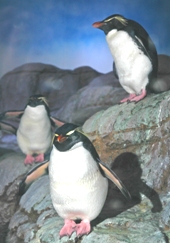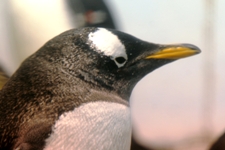 |

| WELCOME EVERYONE!!! |

|
| TO THE OCEANS EXHIBIT AT THE INDIANAPOLIS ZOO!!! |
I am very pleased to share with all of you The Ocean Exhibit
at The Indianapolis Zoo here in Indianapolis, Indiana! I hope that you are enjoying the Web Site and that you enjoy the rest
of the Photos and Information. Please come back often and bring your Family and Friends along wtih you so they too can enjoy
all the Wonderful, Fascinating Photos!!!!
GOD BLESS ALL OF YOU AND YOUR FAMILIES!!!!
| ROCKHOPPER PENGUINS |

|
| AT THE INDIANAPOLIS ZOO!!! |
The Oceans Exhibit will present a wide variety of Fish and
Invertebrates that call these Watery Environments, Home, along with one of the Oceans' most well known Bird Species (Penguins)
and several of the fascinating Mammals whose lives are connected to the Salt Water Habitats on which they depend.
The Featured Species Include:
Sharks, Seahorses, Eels, Jellyfish, Seals & Sea Lions, Penguins, and Polar Bears.
Penguins-An Overview
Penguins are flightless Sea Birds of the Southern Hemisphere. In all, there are 18 Species
of Penguins found in South Australia, New Zealand, and off the Coasts of Peru, Chile, and South Africa. Some Species live
as far North as The Equatorial Galapagos Islands, but they are primarily Cold-Weather Birds. There are Seven Species of Antarctic
Penguins: The Adelie, Gentoo, Macaroni, Chinstrap, Rockhopper, King, and Emperor. The Adelie and the Emperor are the two true
Antarctic Species.
The Oceans presented by old National Bank feature Three Penguin Species: King Penguins, Gentoo
Penguins and Rockhopper Penguins.
Penguins have a heavier Skeleton tha;n most Birds, Waterproof Feathers, and Specialized Glands
that extract and excrete excess Salt. Thier Feathers, which cover their Bills and Feet, combine with a thick layer of Fat
to insulate them. This works so effectively that the Birds frequently overheat in the Frigid Waters. They vary, by Species,
from the Sixteen Inch, Two and a Half Pound Little Blue Penguin of Australia to the truly Antarctic Sixty-Six Pound Emperor
Penguin, which stands more than Three and a Half Feet tall. (The Emperor has actually been recorded at up to 90 Pounds.
Penguins swim like other Birds fly. Their Wings have not disappeared nor have they become
vestigial, useless appendages.
Instead, they've evolved into Flippers. Penguins use highly developed Muscles to flap their
Wings to move forward, and they guide themselves with their Tail.
They are the only Bird to "porpoise." That is to say, they launch themselves out of the Water,
momentarily flying in the Fluid Arches as they continue to swim forward at high speeds like Dolphins.
Penguins do this in order to breathe, but porpoising also creates Air Bubbles that reduce
friction during swimming.
Gentoo Penguins are thought to be the fastest of all Swimming Birds, achieving Speeds of Thirteen
to Seventeen Miles Per Hour.
Penguins Breed in Colonies and can be fiercely territorial. They Breed closely together mostly
because there is very little Ice-Free Space. But they are also highly Social Animals that recognize individuals and return
as Adults to the Rookery where they were Born. The Colony helps these Birds guard, protect, and defend their Young. Within
these Colonies, Penguins build Rookeries with Pebbles and Guano. (The Emperor does not build any Nest because it Breeds on
the Ice.)
Penguins fall Prey to Leopard Seals, Sea Lions, and Killer Whales. Skua Gulls are the greatest
natural threat to Chicks and Eggs. In their turn, Penguins dive to hunt Fish, Squid and Krill-a samll Shrimp-like Crustacean.
Krill is a very large part of the Diet. (In fact, the Penguins' dependence on Krill was demonstrated in dramatic fashion in
1995, when Thousands of Adelie and Emperor Chicks died due to unusual movements of Krill Swarms.) Most Penguins submerge for
about one minute, but Emperors can dive as deep as 180 Feet for up to 18 minutes.
The Macaroni and Rockhopper Penguins are in the same Genus, Eudyptes.
Both have Yellow Crests decorating and distinguishing their Heads. In fact, the Macaroni gets
its name for this feature after "Macaroni Dandies,"
resplendently Dressed 18th Century Englishmen. Some Macaronis
Breed on the Antarctic Peninsula. The Five and a Half Pound Rockhopper is the smallest Antarctic Species, but it compensates
for its smallness by being the most aggressive of all Penguins.
| GENTOO PENGUIN |

|
| AT THE INDIANAPOLIS ZOO!!!! |
The Gentoo, Chinstraps, and Adelies are the Southernmost Representatives
of the Genus Pygoscelis. these Three Species are roughly the same size.
The Gentoo is the rarest of the Three, with a Population of about 350,000 to be found largely
on South Georgia, an Island Northeast of the Peninsula.
The Chinstrap gets its name from Markings on its Head and Neck, and it is considerably more
abundant, at about Ten Million.
Some Chinstrap Penguins Breed on the Antarctic Peninsula. The Adelie is the most numerous
of the Antarctic Penguins; it is also the Species with the Classic Penguin look, being White and Black with no adornments.
On average, an Adelie weighs about 11 Pounds and stands a little less than Thirty Inches tall. Along with the Emperor, the
Adelie Breeds widely on the Continent proper. Its Colonies sometimes number in the Millions.
The remaining Two, the Emperor and the King of the Genus Aptenodytes, look more alike than
different. However, the Emperor is considerably larger, weighing twice as much on average. They both have Yellow and Orange
Markings around the Neck (although the King's are brighter and tend more toward Orange.) Black Heads, White Bellies, and Blue-Grey
Backs.
The King Breeds on the subAntarctic Islands, while the Emperor Breeds on the Continent's Ice.
Oddly, it is the only Bird that will live off Land its entire Life.
Six of the Seven Antarctic Species Breed during the Summer; the Emperor Breeds during the
unbelievably Cold, Dark Antarctic Winter. This is because the Emperor has a longer Gestation Period than other Penguins, so
it must time its Cycle in order to ensure its Chicks become Independent during the Summer abundance of Food.
The Adults sacrifice greatly to do this, however. Both the Males and Females must incubate
the Egg continually on their Feet, fasting up to Three Months during the Winter.
Today, Penguins are economically important in South America and South Africa for their Guano,
used for Fertilizer, and as Tourist Attractions.
In the Past, Commercial Egg Collecting caused Severe Damage to Rookeries.
Around the turn of the Century, Penguins were also slaughtered for their Blubber--especially
the King. However, Present Day Antarctic Penguins find their greatest Human Threats from inadvertent interference.
Since nearly all of Antarctica is covered in Ice, competition for Breeding Space among Penguins
alone is difficult enough. However, the introduction of Tourism and Airstrips on the Continent, can affect Penguins in unpredictable
and dangerous ways.
Unfortunate incident like the building of the French Airstrip Dumon d'Urville on the rocky
Adelie Coastline have ruined some of the best Bird Breeding areas on the Continent. (In 1944, a Tidal Wave washed away a good
deal of that Airstrip.)
Two recent studies demonstrate that Penguins have been infected with Diseases most likely
spread by carelessly discarded Poultry.
Australian Scientists operating out of Mawson Station detected Antibodies for Infections Bursal
Disease Virus (IBDV) in Emperor Chicks and Adult Adelies, and Swedish Scientist found Salmonella in Penguins on Bird Island.
Under the Antarctic Treaty System the Agreed Measures for the Conservation of Antarctic Fauna
and Flora (Recommendation 111-8 of 1964) prohibit Killing, Wounding, Capturing, or Molesting any Native Mammal or Bird in
Antarctica without a Permit. The Agreed Measures are included in and strenghtened by the Protocol on Environmental Protection
for the Antarctic Treaty. Annex II to the Protocol prohibits the Import of Live Poultry, and requires specific treatment for
Dressed Poultry and its disposal.
|

